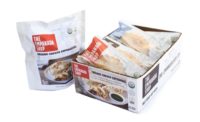Ready-to-eat, protein bowls and pre-made entrees continue to be popular. Have food safety regulations kept up?
“Overall, the most important aspects regulatory wise are the applications of the compliance guidelines for lethality, cooling and holding of meat and poultry products (Appendix A and B),” says Rafeal Rivera, manager of food safety and production programs at the U.S. Poultry & Egg Association, based in Tucker, Ga. “These guidelines were updated over a year ago, but there is a need to clarify how the data applies to today’s processes and equipment.”
The U.S. Department of Agriculture’s Food Safety and Inspection Service (FSIS) first published Appendix A, Compliance Guidelines for Meeting Lethality Performance Standards for Certain Meat and Poultry Products, in 1999, with revisions in 2011, 2012 and 2017. The latest version of Appendices A and B informs ready-to-eat (RTE) meat and poultry processors about safe harbor guidelines. Specifically, Appendix A addresses lethality requirements in RTE products and Appendix B helps processors meet the cooling and stabilization requirements for heat-treated RTE and non-RTE meat and poultry products.
FSIS postponed enacting the guidelines until the spring of 2019 because the Appendices ask for a large amount of work to validate hazardous analysis and critical control points (HACCP) and food safety claims, says Bob Delmore, Ph.D., professor in the Department of Animal Sciences at Colorado State University, based in Fort Collins.
“Industry, academia and trade associations are working together to fund research, develop validation procedures for HACCP plans and demonstrate that current processes are adequate to ensure that lethality of food-borne pathogens of concern are achieved,” Rivera says.
FSIS instigated the latest changes to Appendix A to clarify humidity levels in cooking and prevent Salmonella outbreaks in RTE meat and poultry products because of Good Manufacturing Practice regulations or post-lethality recontamination of products.
“Appendix A allows processors to have a starting point with cooking guidelines — humidity, timing and temperature — so they don’t have to figure out everything from scratch,” says Delmore. “They could come up with their own validation of HACCP claims, but they may prefer not to spend time and money on their own research.”
What’s for dinner?
Are heat-and-eat and ready-to-eat meat and poultry dishes taking sales from fresh meat? According to the Food Marketing Institute’s 2019 Power of Meat report, prepared by 210 Analytics, it doesn’t seem like it. Most consumers still make dinner with fresh meat or poultry (68 percent), while 24 percent mix and match fresh and fully cooked, heat-and-eat meat/poultry items. Just 8 percent of shoppers mostly rely on fully cooked meat/poultry that needs to be re-heated.
Not surprisingly, Boomers prepare dinner from fresh meat/poultry the most (74 percent), although all of the other age groups (from Gen Z to Gen X) consistently show a preference for fresh meat. Younger consumers, however, are more likely to try fully cooked meat/poultry, with Gen Z (12 percent) and Younger Millennials (13 percent) most open to it.
Prioritizing yield and consistency
Facility environments have certainly changed over time to prevent pathogens. “As facilities gain more uses with raw and ready-to-eat products, does the organization change its sanitation substantially?” Delmore asks.
RTE products also have to maximize palatability while maintaining shelf life and preventing lethality.
“Yield and consistency are always critical components,” says Delmore. “Survivability vs. lethality continues to be an important challenge while creating palatability.”
Pass-through ovens are a somewhat new piece of equipment that can load raw meat or poultry, cook it and unload it between processing areas. The cooked product can be unloaded on the opposite side to prevent cross contamination from handling meat.
“Usually, I don’t like all-in-one units, but I think it’s OK for like items to be together and/or to use the same specific form and function,” Delmore says.
Monitoring cooking time and temp
Oven temperatures are also being monitored and controlled with more probes. “They are not new, but probes measure the surface temperature, which is important,” Delmore says. “It’s more important than ever to have data to validate cooking processes.”
Processors can use in-oven thermometers with easy-to-read digital screens placed on or next to the oven, so doors don’t need to be opened until the food is done. Probes are inserted into the food, and a high-heat silicone cord connects them to the thermometer, which beeps when the requested internal temperature of the food is reached. Thermometers today can be pre-programmed with desired temperatures and/or come preset with the USDA recommended safe temperatures for beef, veal, lamb, pork and poultry.
“Smokehouse microprocessors also track cooking time and temperature through remote controls, via Wi-Fi on smart phones,” says Tracy Smaciarz, president and head butcher at Heritage Meats, based in Rochester, Wash. “We have a system that monitors temperature and our humidity control system.”
Microprocessors can also be designed for stand-alone use, displaying a front panel, controls, program menu and keys. Mini-microprocessors can also control oven conditions and related systems such as smoke generators, clean-in-place, etc. They utilize a pen wet/dry bulb chart recorder for documentation and control.
Controlling cooking and storing
“A newer technology — which I don’t have — is the ability to smoke and chill product in one cooking cabinet,” Smaciarz says.
For cross-contamination prevention, the USDA requires keeping cold or raw products separated. “So in my facility, we put product into the smokers, then take them into another area for cooling,” Smaciarz says. “Then, we bring them out of there to another area for packaging. It’s a lot of steps.”
The benefit of a chilling room though — besides food safety — is it frees up the oven for another load of cooking, Delmore says.
Air fryers have received quite a bit of attention on the consumer front recently, but conventional fryers remain popular with industry products. However, processors always have to pay attention to proper controlled methods for cooling and storing products before packaging. In addition, the quality of the frying oil — and whether it contains allergens — is a critical component of thermal processing.
“Companies with recalls, in general, mostly have undeclared allergens,” Smaciarz says. “So it’s important to make sure the label is current — with soy, wheat, dairy and crustacean.”
Vegetable oils used in prepared foods can contain peanut oil, soybean oil, sunflower seed oil, corn oil or palm oil. The refining process (or heat process) generally removes the protein that causes the allergic reaction. Crude oils, on the other hand, should be avoided by those with food allergies because those proteins aren’t removed. They can also be labeled as gourmet, cold pressed or raw oil.
Delivering systematic thermal processing
Batch ovens and continuous ovens are utilized with many of the trending beef products today, such as beef bowls and jerky, Delmore says.
Industrial batch ovens can bake, cure, dry, form and pre-heat products. They are known for being a closed system, holding large or unusually shaped parts and requiring less capital and maintenance. But they have a slower production time, require more manual labor for loading and unloading, suffer heat loss if product has to cool down in the single chamber and can have uneven heating.
Continuous ovens are ideal for mass-produced products that require systematic and consistent thermal processing. While they are more expensive, they deliver return on investment over time because of their benefits. Their advantages are direct, consistent heat; temperature monitoring and recording; temperature zones; automatic doors; separate heating and cooling chambers; and consistent cooling.
Before poultry products are loaded into ovens, employees have to be on the lookout for coarse breast fillets after birds are defeathered, because of the somewhat recent but persistent threat of woody breast (tough meat tissue). Poultry workers are becoming skilled at recognizing the condition and removing woody cuts from the production line before they are processed.
“On the food products front, a challenge that industry is working on is to find outlets for woody breast products,” Rivera says. “There is plenty of research to eliminate the problem, and adjustments are underway. In the meantime, there is also the need to research how to make the most of products with this quality defect.”
Many woody breast fillets are processed as ground chicken or chicken nuggets.
In today’s complicated regulatory and production environment, it’s always important to not lose sight of the basics.
“For most processors, keep it clean, keep it cold and keep it moving, and things will go pretty smoothly,” Smaciarz says. NP








Report Abusive Comment